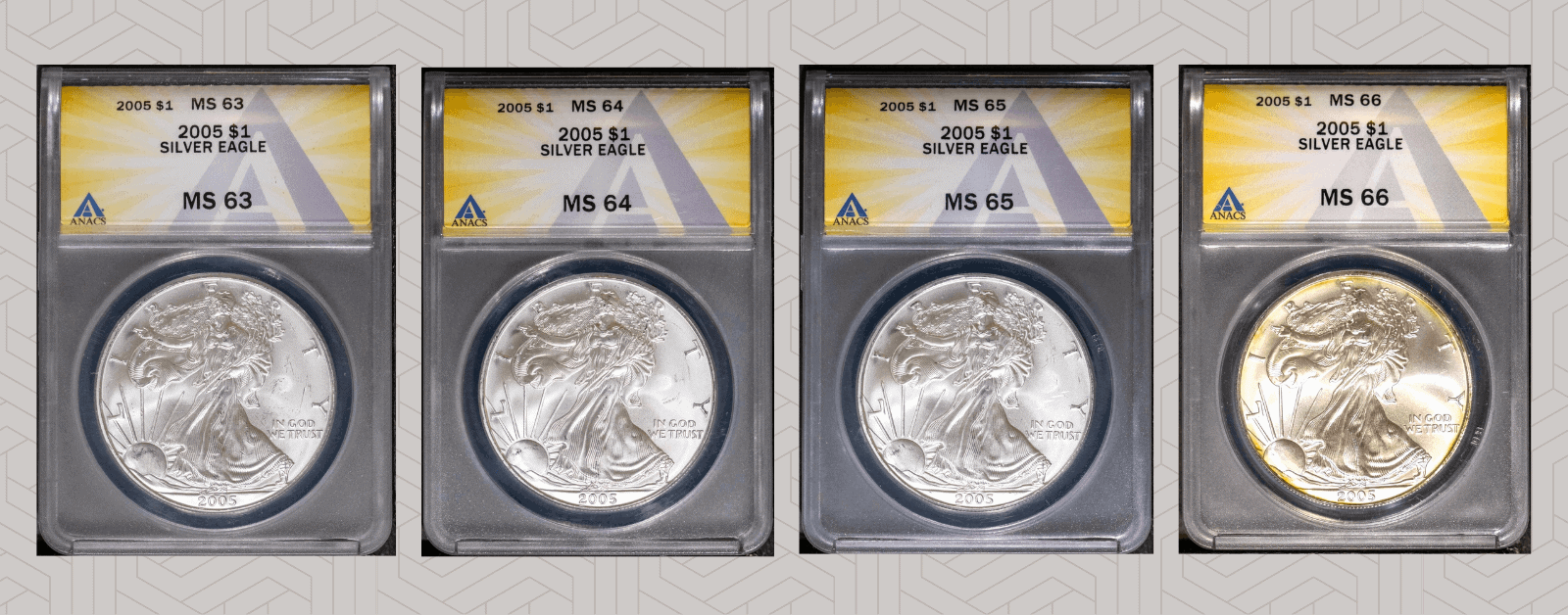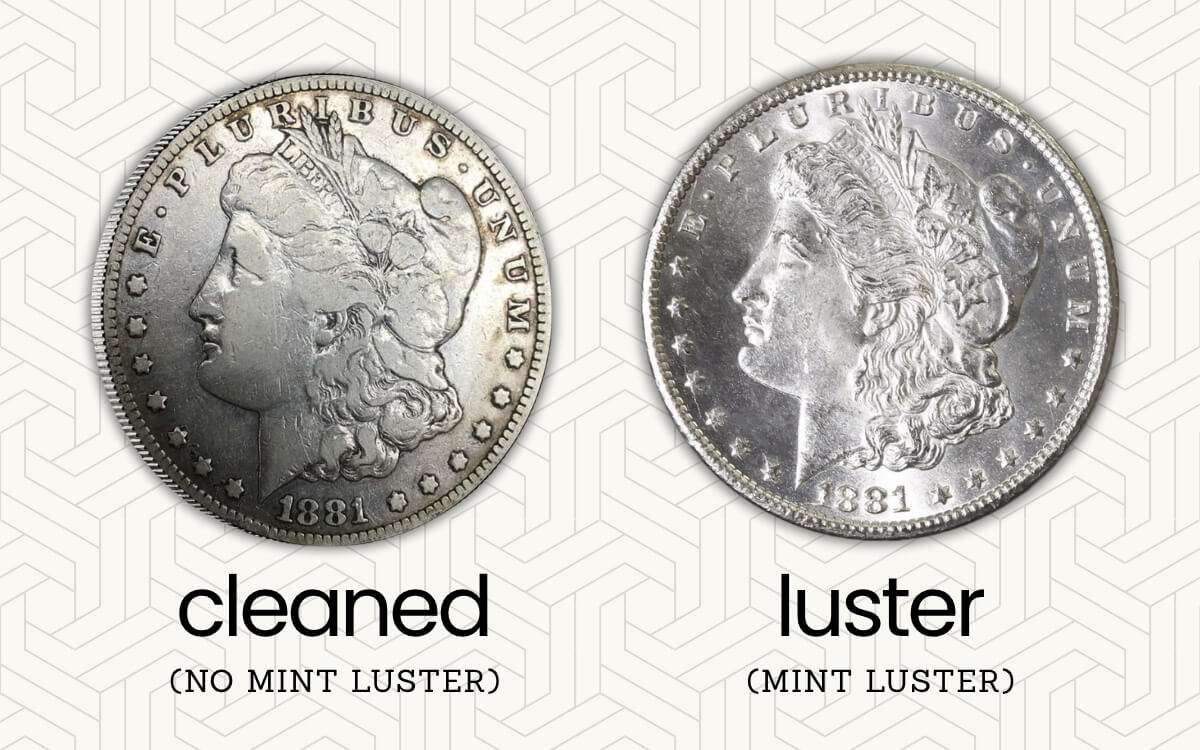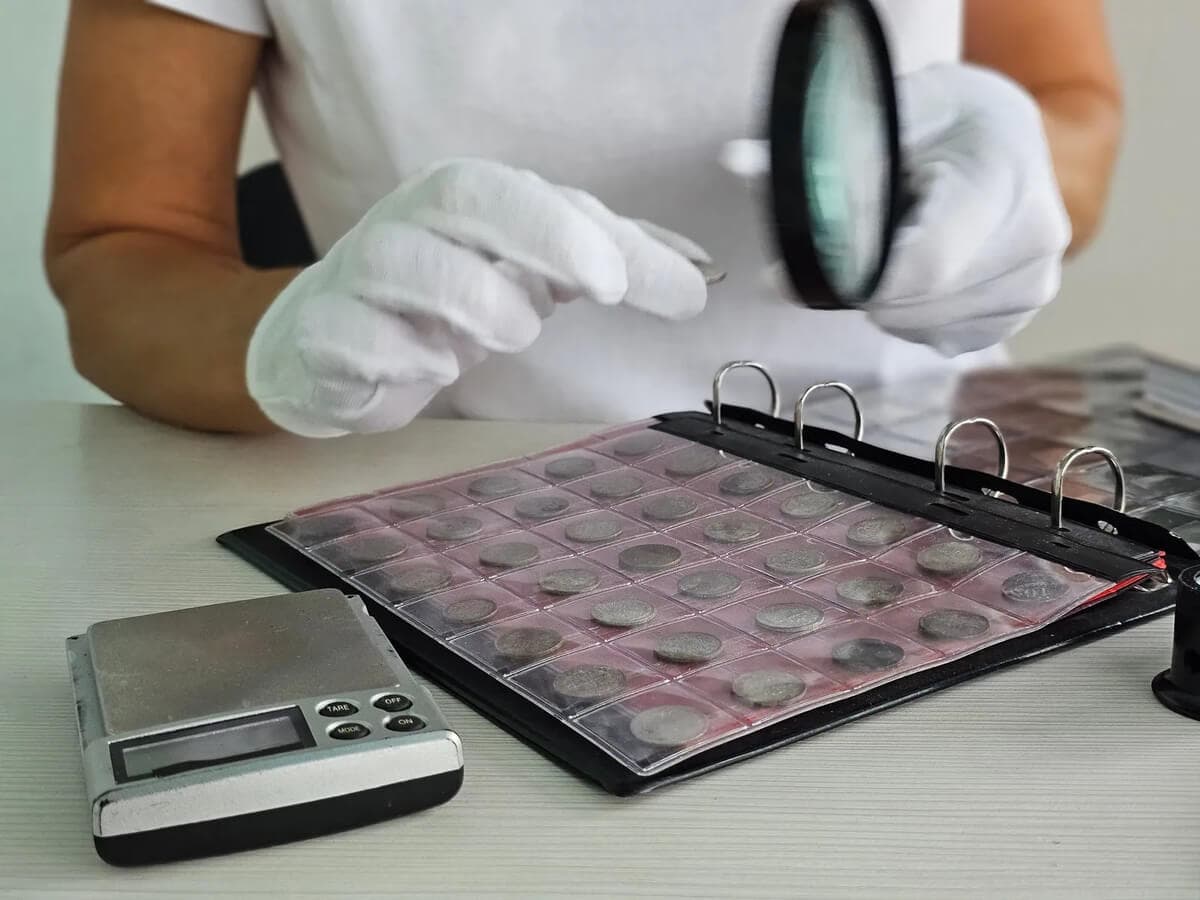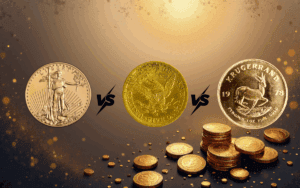Learn the essential skills collectors need to evaluate coin condition, understand grading scales, and make informed purchasing decisions.
Two coins of the same type and year can have values that differ by hundreds of dollars based solely on condition. Last month, I examined two 1921 Morgan silver dollars side by side – one graded Very Fine 30 sold for $45, while an About Uncirculated 58 brought $125. That $80 difference? Pure condition.
Why Coin Grading Matters
Coin grading is the foundation of the entire numismatic market. Every serious collector needs to understand how condition affects value, whether you’re buying your first Morgan dollar or building an investment portfolio.
The modern grading system uses the Sheldon Scale, running from 1 (barely identifiable) to 70 (absolute perfection). Circulated coins (grades 1-58) show wear from actual use, while uncirculated coins (grades 60-70) never entered circulation but may have contact marks from storage.
Dr. William Sheldon created this framework in 1949 for pricing Large Cents, where grade numbers corresponded to actual market values – a VF-20 cent was worth $20-30, while a Mint State example ranged from $60-70. In 1977, the American Numismatic Association adapted his 70-point scale for all U.S. coins, creating today’s industry standard.
Not every number gets used – you’ll see coins graded 12, 15, 20, but never 16, 17, or 19. These gaps exist because Sheldon’s original scale only used specific increments that corresponded to his pricing system. When the ANA adapted it for universal use, they kept these traditional grade points rather than filling every number.
The Money Behind the Numbers
Here’s what these grades mean for your wallet. A Morgan silver dollar in Good condition trades around $35. That same coin in Mint State 65? Try $300 or more. Understanding these differences prevents costly mistakes.
Professional grading services like PCGS, NGC, and ANACS provide third-party authentication. Their certified holders offer tamper-evident protection and create the liquid secondary markets we see today. NGC even adds Plus (+) designations for coins at the high end of their grade and Star (★) for exceptional eye appeal – distinctions that can add 10-20% to value.
Complete Coin Grading Scale: PO-1 to MS-70
Circulated Grades (PO-1 to AU-58)
Circulated grades dominate the vintage coin market, ranging from barely identifiable PO-1 examples to AU-58 coins with just a trace of friction. Understanding these wear patterns helps you spot misgraded coins and find better values.
Heavily Worn (PO-1 to AG-3): Poor to About Good
Poor (PO-1) represents the absolute minimum collectible condition – you can identify the coin type and sometimes the date, but one side might be completely blank. These “lowball” coins actually command premiums among specialized collectors seeking the worst possible examples.
Fair (FR-2) shows minimal detail, better than Poor but still heavily worn with most features gone.
About Good (AG-3) represents a step up with basic outlines becoming clearer – Liberty’s head is distinguishable though features remain smooth. These grades matter mainly for key dates where any example has value.
Well-Worn (G-4 to VG-10): Good to Very Good
Good (G-4 to G-6) grades show clear major design elements despite heavy wear. On a Morgan dollar, Liberty’s profile remains distinct. G-4 coins have slightly worn rims with peripheral lettering nearly full, while G-6 shows complete rims and full peripheral lettering.
Very Good (VG-8 to VG-10) represents the sweet spot for budget collectors. About 75% of the original design survives. VG-8 shows 2-3 letters of LIBERTY on coins with this feature, while VG-10 displays 5-6 letters clearly.
Lightly Worn (F-12 to EF-45): Fine to Extremely Fine
Fine (F-12 to F-15) coins retain all major details with moderate wear. Hair strands stay visible, eagle feathers remain defined. The complete word LIBERTY shows on applicable coins, though it may be weak. You might spot original mint luster hiding in protected areas around letters.
Very Fine (VF-20 to VF-35) grades offer excellent value. VF-20 shows moderate wear on high surfaces, while VF-25 displays all lettering and major features sharply. VF-30 shows light, even wear across surfaces, while VF-35 has minimal wear with traces of original mint luster often visible. Many collectors target VF grades for type sets – coins with character that retain strong eye appeal.
Extremely Fine (EF-40 to EF-45) examples show just slight wear on high points. Nearly full details remain with substantial luster. The difference between EF-40 and EF-45? Mainly the amount of remaining mint luster. For collectors who want quality without mint state premiums, EF grades hit the mark.
Barely Worn (AU-50 to AU-58): About Uncirculated
About Uncirculated coins challenge even experienced graders because the wear is so minimal it requires careful examination to detect. AU-50 shows traces of wear on highest points with some original luster. AU-53 displays more luster with less obvious wear.
AU-55 retains considerable luster with wear mainly visible as slight color differences. AU-58 shows only the slightest friction on the highest points – sometimes requiring magnification to detect the difference from MS-60. Many collectors target AU-58 for “everyman sets” that exclude mint state coins.
Uncirculated Grades (MS-60 to MS-70)
Mint state coins never saw circulation, but quality varies wildly from heavily marked MS-60s to perfect MS-70s. According to NGC’s standards, MS-70 means “no post-production imperfections at 5x magnification” – a standard few coins achieve.

Lower Mint State (MS-60 to MS-62): Technically Uncirculated
MS-60 shows heavy bag marks and possible weak strike. MS-61 has fewer marks and better eye appeal. MS-62 approaches average quality with noticeably fewer distractions, though still below most collector preferences.
Choice Mint State (MS-63 to MS-64): Collector Quality
MS-63 represents average mint state quality, while MS-64 shows above-average strike and fewer marks. This range offers the sweet spot for many collectors – mint state status without crushing premiums.
Gem Mint State (MS-65 to MS-66): Premium Quality
MS-65 shows strong strike with minimal marks, while MS-66 displays superior quality with only minor imperfections. Values often double or triple from MS-63.
Superb Mint State (MS-67 to MS-70): Near Perfect to Perfect
MS-67 has virtually no visible marks without magnification. MS-68 approaches perfection with only the tiniest imperfections under magnification. MS-69 shows near-perfect surfaces. MS-70 means absolute perfection – rare and expensive, especially for older coins.
Special Strike Types
While most coins were struck for commerce, the U.S. Mint has always produced special coins for collectors using different production methods and finishes.
Proof Coins (PF/PR 1-70): Collector Strikes
Proof coins, struck specially for collectors with polished dies and planchets, use the same 70-point scale but with PF or PR prefixes. Unlike business strikes, proofs were never intended for circulation.
Impaired Proofs (PF 1-59) are proof coins that show wear or mishandling – unusual but occasionally seen when patterns or presentation pieces accidentally entered circulation. These follow the same grade descriptions as circulated coins.
Proof 60-70 mirrors the mint state scale for quality, but these coins display distinctive mirror-like surfaces. A PF-63 is sometimes called “Choice Proof,” while PF-65 represents “Gem Proof” quality. Many modern proofs achieve PF-69 or even PF-70, unlike their business strike counterparts.
Proof coins often receive special designations like Cameo or Ultra Cameo (also called Deep Cameo) for strong contrast between frosted devices and mirror fields – features that significantly increase value.
Specimen Strikes (SP): Between Proof and Business
Specimen (SP) strikes fall between proofs and business strikes, typically seen in special mint sets and presentation pieces. While not as refined as proofs, they show superior quality to regular circulation strikes. These appear occasionally in special sets and government presentation pieces.
What Graders Actually Look For
Professional graders examine far more than simple wear patterns. Understanding these factors helps you spot problems and opportunities.
Strike Quality
Not all coins leave the mint equal. Sharp strikes show complete design transfer with crisp details. Weak strikes lack central detail even in mint state – Buffalo nickels notorious for this. Importantly, the ANA standards note that weak strikes from worn dies don’t necessarily lower grades for early coins where this was common.
Common strike designations include:
- FB (Full Bands) – Mercury and Roosevelt dimes
- FS (Full Steps) – Jefferson nickels
- FH (Full Head) – Standing Liberty quarters
- FBL (Full Bell Lines) – Franklin half dollars
Die axis alignment matters too. Most U.S. coins use medal alignment (flip vertically, reverse is upside down). Finding coin alignment (0 degrees) can indicate interesting varieties or mint errors.
Luster and Surface Preservation
Original mint luster creates that distinctive “cartwheel effect” when you tilt the coin under light. Cleaned coins show harsh brightness with unnatural directional lines. Once cleaned, these coins will always be considered damaged and receive “Details” grades regardless of wear level (typically reducing value by 50-70%.)

Bag marks from mint storage are expected on most coins. But post-mint damage (scratches, rim nicks, PVC residue from bad holders) creates problems that slash both grades and values.
Special Designations and Surface Qualities
Professional services use various designations to describe specific coin characteristics:
For Copper Coins:
- RD (Red) – 95%+ original red color
- RB (Red-Brown) – 5-95% red color
- BN (Brown) – Less than 5% red
For Proof Coins:
- Cameo – Moderate contrast between fields and devices
- Ultra/Deep Cameo – Strong, frosted contrast
Quality Indicators:
- Plus (+) – High end for the grade (NGC, PCGS)
- Star (★) – Exceptional eye appeal (NGC)
- CAC Sticker – Green or gold verification of quality for the grade
Natural toning that develops over decades can enhance value – NGC’s Star designation specifically recognizes this superior eye appeal. Artificial toning meant to hide problems? That results in “Questionable Color” details grades.
DIY Grading vs. Professional Services
You can grade common dates worth under $100 yourself, but the jump from AU-58 to MS-60 is tricky. Even the slightest wear can drop the value by 30% or more, and spotting that difference takes practice.
Tools for Self-Assessment
Proper lighting makes all the difference. Halogen reveals true colors and that distinctive “cartwheel” luster pattern better than LED. Position your light at 45 degrees and slowly rotate the coin. You’re watching how light plays across the surface, looking for breaks in luster that indicate wear on high points like Liberty’s cheek or the eagle’s breast.
Magnification (5x to 10x) reveals what naked eyes miss: hairlines from old cleanings, contact marks, and subtle wear. A simple jeweler’s loupe works fine.
The ANA grading standards book provides comparison photos for each grade. Match your coin to these benchmarks, focusing on the specific series you’re grading.
Digital calipers help verify authenticity by checking diameter and thickness against official specifications—particularly useful for trade dollars and gold coins where counterfeits are common.
Remember to always handle coins by their edges. Even clean hands leave oils that damage surfaces over time. Work over a soft cloth or pad in case you drop the coin.
When to Use Professional Services
Economics drives the decision, but the math isn’t always straightforward.
- Under $100 value: Grade it yourself unless it’s a key date
- $100-300 value: Consider grading if single grade differences exceed $50
- $300-500 value: Usually worth grading if you plan to sell
- Over $500 value: Almost always grade for authentication alone
Grading fees vary widely. Economy service runs $15-30 per coin with 30-45 day turnaround, while regular service costs $30-50 with 15-20 day turnaround. Express service at $65+ gets your coins back in under 10 days. Most services require annual membership, but bulk submissions of 20+ coins can reduce per-coin costs significantly.
Choosing the Right Service for Grading
PCGS (Professional Coin Grading Service)
PCGS dominates the U.S. coin market, particularly for Morgan dollars and key date coins. Their holders bring 5-10% higher prices at auctions because dealers trust their consistency. The blue label has become synonymous with liquidity – if you’re building for eventual sale, PCGS typically maximizes value.
Membership starts at $69 annually.
NGC (Numismatic Guaranty Corporation)
NGC offers nearly identical grading standards with more competitive pricing, especially for bulk submissions. They excel with world coins, ancient coins, and tokens that PCGS won’t grade. Their Plus and Star designations help differentiate quality within grades. Many dealers submit to NGC for inventory coins since the cost savings add up.
Membership starts at $25 annually.
ANACS (American Numismatic Association Certification Service)
ANACS pioneered problem coin identification and remains the budget option. While ANACS slabs trade at slight discounts compared to PCGS or NGC, they’re perfect for coins in the $50-200 range where top-tier grading fees don’t make sense. They also grade cleaned coins with detailed problem descriptions, helping you understand exactly what issues affect value.
No membership required.
CAC (Certified Acceptance Corporation)
CAC doesn’t grade raw coins – they only review coins already in PCGS or NGC holders. For $16-35 per coin, they’ll add a green sticker (solid for the grade) or gold sticker (undergraded) if the coin meets their strict standards. Since CAC-approved coins bring 10-30% premiums, this secondary review makes sense for coins worth $500+.
Membership starts at $99 annually.
The Submission Process
Submitting coins feels intimidating at first, but it’s straightforward:
- Join your chosen service or work through a dealer who submits regularly.
- Select the appropriate service level based on coin value and how quickly you need them back.
- List each coin on the submission form with your grade estimate.
- Package coins in non-PVC flips or cardboard 2x2s – never use old plastic that might contain PVC.
- Ship with full insurance and tracking.
Most collectors accumulate coins over several months then submit in batches. This spreads the membership cost and qualifies for bulk pricing. Local coin clubs often organize group submissions for even better rates.
When Grading Doesn’t Pay
Some problems slash values by 50-70%, making grading fees a waste. Always inspect your coins for the following issues before paying to have them graded:
Harsh cleaning shows as parallel hairlines under magnification and unnatural brightness.
Environmental damage appears as dark spots, corrosion, or pitting.
PVC contamination leaves green residue that sometimes can be removed but often leaves the surface damaged.
Rim damage from jewelry mounting or heavy contact significantly impacts value.
If your coin looks unusually bright with hairlines visible under magnification, it’s been cleaned. Save your grading fees. However, a key date coin with issues benefits from authentication, even if it receives a details grade. That 1893-S Morgan dollar, even cleaned, needs the grading service’s verification to sell effectively.
Market Impact of Authentication
Grade differences translate directly to market values, with relationships that follow predictable patterns across most coin types. The examples below demonstrate how even single-point improvements can dramatically affect prices in today’s market.
1921 Morgan Dollar
This common date perfectly illustrates grade progression:
- Poor (PO-1): $25-30
- Good (G-4): $35
- Very Fine (VF-30): $45-50
- Extremely Fine (EF-45): $60-70
- About Uncirculated (AU-58): $80-100
- Mint State 61: $110-130
- Mint State 63: $150-175
- Mint State 65: $300-400
- Mint State 67: $1,000+
American Silver Eagles
Even modern coins, such as the Silver Eagle, show dramatic grade premiums:
- MS-67: $40-45
- MS-68: $45-55
- MS-69: $65-75
- MS-70: $125-175
That single point from MS-69 to MS-70 doubles the value. This is why accurate grading matters. Plus designations at these levels can add another 15-20% premium.
Building Your Grading Skills
Developing reliable grading abilities takes time, but you can accelerate the learning curve.
Start Simple
Begin with heavily worn coins where differences are obvious. Morgan dollars and Walking Liberty halves work perfectly – large designs show wear patterns clearly. Practice distinguishing Good from Very Good before tackling the tricky AU-58 versus MS-60 debate.
Study certified examples at coin shows and local dealers. Compare your assessments to professional grades. Keep notes on what you miss. Most beginners struggle with the AU-50 to MS-63 range where magnification becomes essential. Remember that grading combines technical assessment with market acceptability – what collectors will pay for matters as much as technical perfection.
Level Up Your Knowledge
Join a local coin club. Experienced collectors love sharing knowledge, and you’ll handle more coins in one meeting than months of solo study. The American Numismatic Association offers grading courses both online and at summer seminars.
Online Grading Resources
Population reports from grading services show how many coins exist at each grade level. Auction archives provide thousands of certified coin images for comparison. Study coins with Plus and Star designations to understand what constitutes superior quality within a grade. CAC’s website shows population data for their approved coins, helping you understand which grades tend to be solid or loose.

Professional graders examine thousands of coins annually. You won’t match their expertise overnight, but you can develop competency for common coins while knowing when to defer to professionals on valuable pieces.
Common Questions About Coin Grading
How consistent are grading services?
PCGS, NGC, and ANACS maintain agreement rates above 85% on resubmissions. Remember, grading involves professional opinion, not absolute science. Minor variations happen, especially in the AU-58 to MS-63 range. Crossover success rates (cracking from one service to another) typically run 60-70%.
Can coins improve in grade naturally?
No. Any “improvement” comes from better photography, unfortunate cleaning attempts, or resubmission during market shifts. Coins only go down in grade through mishandling.
What’s the difference between MS and PF grades?
MS (Mint State) grades apply to business strikes made for circulation but never used. PF (Proof) grades apply to specially struck collectors’ coins with mirror-like surfaces. Same scale, different production methods. SP (Specimen) falls between the two.
What percentage of coins survive in mint state?
For modern coins (1960s onward), roughly 15-25% remain uncirculated. Pre-1965 silver coins show much lower survival rates – often under 5% even for common dates. Some issues like the 1802 Draped Bust half dime have no known mint state survivors.
Should I crack coins out of holders?
Usually no. Most resubmissions achieve the same or lower grades. Cracking risks damage and removes the authentication guarantee. Leave this to experts with specific goals or obvious undergraded coins. CAC rejection doesn’t mean crack it out – the coin might be accurately graded but weak for the grade.
Do grading standards change?
Official grading standards remain stable since the ANA formalized them, but market preferences evolve. What constitutes attractive toning or acceptable surfaces shifts gradually over decades. Plus and Star designations emerged to recognize quality within grades.
The Bottom Line
Coin grading fundamentally shapes the numismatic market. Whether you’re hunting bargains in the junk silver box or investing in certified rarities, understanding graded coins and condition assessment protects your wallet and enhances your collecting experience.
Start with what you can see – heavy wear versus light wear. Build from there. Soon you’ll spot the difference between VF-20 and VF-30, understand why dealers pay premiums for CAC-approved coins, and know when that raw coin in the shop is actually a bargain. Educated collectors make smarter purchases every time.



